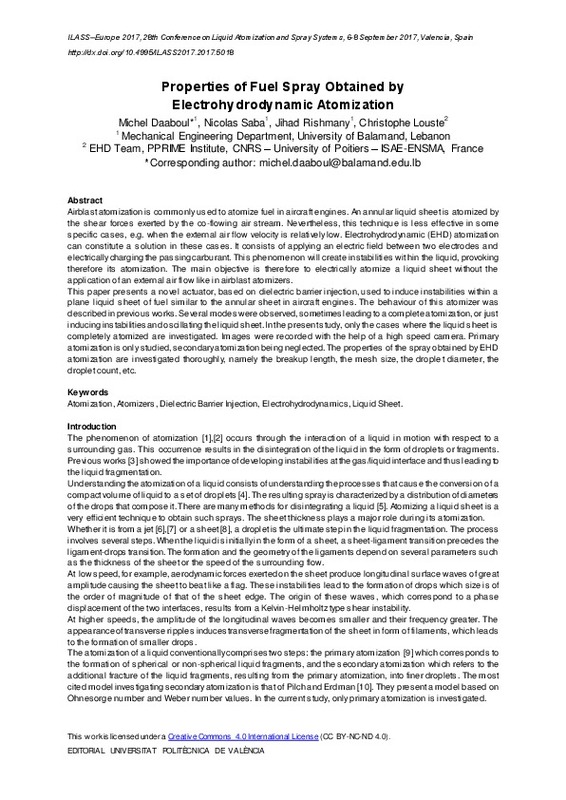JavaScript is disabled for your browser. Some features of this site may not work without it.
Buscar en RiuNet
Listar
Mi cuenta
Estadísticas
Ayuda RiuNet
Admin. UPV
Properties of Fuel Spray Obtained by Electrohydrodynamic Atomization
Mostrar el registro sencillo del ítem
Ficheros en el ítem
| dc.contributor.author | Daaboul, Michel
|
es_ES |
| dc.contributor.author | Saba, Nicolas
|
es_ES |
| dc.contributor.author | Rishmany, Jihad
|
es_ES |
| dc.contributor.author | Louste, Christophe
|
es_ES |
| dc.date.accessioned | 2018-05-09T09:15:02Z | |
| dc.date.available | 2018-05-09T09:15:02Z | |
| dc.date.issued | 2017-07-28 | |
| dc.identifier.isbn | 9788490485804 | |
| dc.identifier.uri | http://hdl.handle.net/10251/101591 | |
| dc.description.abstract | [EN] Airblast atomization is commonly used to atomize fuel in aircraft engines. An annular liquid sheet is atomized by the shear forces exerted by the co-flowing air stream. Nevertheless, this technique is less effective in some specific cases, e.g. when the external air flow velocity is relatively low. Electrohydrodynamic (EHD) atomization can constitute a solution in these cases. It consists of applying an electric field between two electrodes and electrically charging the passing carburant. This phenomenon will create instabilities within the liquid, provoking therefore its atomization. The main objective is therefore to electrically atomize a liquid sheet without the application of an external air flow like in airblast atomizers. This paper presents a novel actuator, based on dielectric barrier injection, used to induce instabilities within a plane liquid sheet of fuel similar to the annular sheet in aircraft engines. The behaviour of this atomizer was described in previous works. Several modes were observed, sometimes leading to a complete atomization, or just inducing instabilities and oscillating the liquid sheet. In the present study, only the cases where the liquid sheet is completely atomized are investigated. Images were recorded with the help of a high speed camera. Primary atomization is only studied, secondary atomization being neglected. The properties of the spray obtained by EHD atomization are investigated thoroughly, namely the breakup length, the mesh size, the drople t diameter, the droplet count, etc. | es_ES |
| dc.format.extent | 8 | es_ES |
| dc.language | Inglés | es_ES |
| dc.publisher | Editorial Universitat Politècnica de València | es_ES |
| dc.relation.ispartof | Ilass Europe. 28th european conference on Liquid Atomization and Spray Systems | es_ES |
| dc.rights | Reconocimiento - No comercial - Sin obra derivada (by-nc-nd) | es_ES |
| dc.subject | Atomization | es_ES |
| dc.subject | Atomizers | es_ES |
| dc.subject | Dielectric Barrier Injection | es_ES |
| dc.subject | Electrohydrodynamics | es_ES |
| dc.subject | Liquid Sheet | es_ES |
| dc.title | Properties of Fuel Spray Obtained by Electrohydrodynamic Atomization | es_ES |
| dc.type | Capítulo de libro | es_ES |
| dc.type | Comunicación en congreso | es_ES |
| dc.identifier.doi | 10.4995/ILASS2017.2017.5018 | |
| dc.rights.accessRights | Abierto | es_ES |
| dc.description.bibliographicCitation | Daaboul, M.; Saba, N.; Rishmany, J.; Louste, C. (2017). Properties of Fuel Spray Obtained by Electrohydrodynamic Atomization. En Ilass Europe. 28th european conference on Liquid Atomization and Spray Systems. Editorial Universitat Politècnica de València. 480-487. https://doi.org/10.4995/ILASS2017.2017.5018 | es_ES |
| dc.description.accrualMethod | OCS | es_ES |
| dc.relation.conferencename | ILASS2017 - 28th European Conference on Liquid Atomization and Spray Systems | es_ES |
| dc.relation.conferencedate | September 06-08,2017 | es_ES |
| dc.relation.conferenceplace | Valencia, Spain | es_ES |
| dc.relation.publisherversion | http://ocs.editorial.upv.es/index.php/ILASS/ILASS2017/paper/view/5018 | es_ES |
| dc.description.upvformatpinicio | 480 | es_ES |
| dc.description.upvformatpfin | 487 | es_ES |
| dc.type.version | info:eu-repo/semantics/publishedVersion | es_ES |
| dc.relation.pasarela | OCS\5018 | es_ES |








